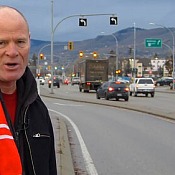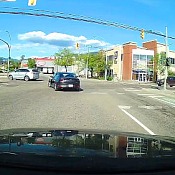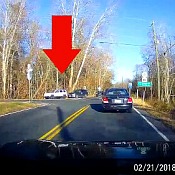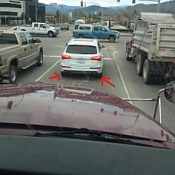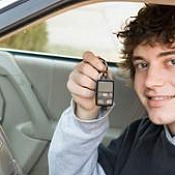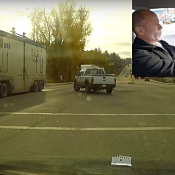Learn how to do a U-Turn to pass your road test - watch the video.
How to Do A U-Turn to Pass a Road Test | Step-by-Step Instructions
Closed Caption
Introduction
Hi there smart drivers.
Rick with Smart Drive Test talking to you today about U-turns; step-by-step instructions to execute a U-turn for the purposes of passing a road test.
Stick around, we'll be right back with that information.
[INTRO & MUSIC]
Hi there smart drivers.
Welcome back.
Rick with Smart Drive Test talking to you today about how to execute a U-turn; step by step instructions to pass a road test.
Now just before we get started here, if you're new to Smart Drive Test, Smart Drive Test helps new drivers get a license regardless of class, veteran drivers to remain crash free, and CDL drivers to start a career as a truck or bus driver.
So if you're new here, hit that subscribe button.

As well, hit that bell.
That way you'll get instant notification when I get the videos up for you.
Now U-turns!
And the reason that I probably haven't done this video yet-- although I've had requests from other smart drivers and the latest request was from Francesca--and they wanted me to do this video on U-Turns.
And the reason I haven't done this is because U-turns are not part of the driving culture in many places.
Here in Canada--British Columbia specifically--Australia, it was not part of the driving culture in Australia.
However, there are places in the world where they do do these.
And the southwest of the United States and Arizona was one of the places that I remembered a lot of U-turns being done.
So we're going to go over that today and you will have to do this.
There are places on road tests that you'll have to do this, usually in cul-de-sacs and whatnot.
Now I just want to go over the driving manual here in British Columbia, "Learn to Drive Smart."

And there are several places that you cannot do U-turns when you're driving.
First one is any time it interferes with other traffic.
And that's basically the catch-all where they get you if you get into a crash.
The police can use that that because you were interfering with other traffic.
And the police will charge you with negligence in executing a U-turn when you shouldn't have been executing a U-turn.
So know that's the catch-all.
1) Anytime that the U-turn interferes with traffic.
2) As well, you cannot execute a U-turn on a curve
3) on the crest of a hill where you cannot be seen for 150 meters or 500 feet.
4) You cannot execute one at traffic lights.
5) You cannot execute one in a business district, except at intersections where it's not controlled by traffic lights.
6) Any time that signs prohibit you making a U-turn.
7) And finally, any time that municipal bylaws prohibit you from doing a U-turn.

So there's seven legal requirements that have to be met in order for you to be able to do a U-turn here in British Columbia.
And that very much underscores what I taught in my legal history courses: that the laws reflect the values of society.
And the driving society here in British Columbia does not do U-turns.
And it's a high-risk maneuver.
Thus all of the regulations and bylaws that are in place to prevent you from doing a U-turn.
So I'm going to show you where to do that.
I'm going to show you how to do them safely and do them for the purposes of a road test.
And out on a road a two-lane road and those sorts of things to give you some idea of the inherent risks in doing a U-turn.
Now if you can go around the block I do recommend that you going around the block, rather than doing a U-turn because think about it - maybe two or three minutes of just going around the block is going to potentially save you being involved in a crash and executing a high-risk maneuver.
So what we're going to do here, we're going to hook up the cameras, go for a drive and show you how to execute U-turn for the purposes of passing a road test, where you might have to do this on a cul-de-sac.
I know that they do do that here in British Columbia and other places where you might have to do a U-turn.
Oftentimes if they make you do a U-turn on a road test it's going to be in a quiet residential area.

So just know that.
So let's hook up the cameras & go for a drive.
U-Turn at a Cul-de-Sac
And on a road test, for the purposes of a road test, they're going to get you at a dead-end street where there's a cul-de-sac - that's almost a given on a road test.
They're going to make you do a U-turn at the end of a street such as this one.
Here where you're going to do a U-turn.
Again go slowly, check the traffic behind you, make sure there isn't any traffic coming.
Okay signal to the left and of course you want to go nice and slow here because there's lots of ice here and it's going to be bumpy.
And the slower you go the sharper the vehicle turns.
So you can get around here.
And you can see that it is very bumpy.
That we're bumping around here.

And we cancel our signal and bring the steering wheel back to straight.
And it's that easy to do a U-turn in a cul-de-sac where there may or may not be able to get you to do a U-turn for the purposes of your road test.
U-Turn at an Intersection
Now in some of these communities like here in Vernon and other places they're going to have cul-de-sacs and they're going to make you do a U-turn at a cul-de-sac.
And we're going to come up here and we're going to do a U-turn at the intersection here.
And we're slowing down.
We're checking the traffic behind us.
Making sure there isn't anybody coming.
We're signaling.
A signal to the right - checking the cross traffic.
There's isn't any cross traffic as we move into the intersection.
Signals to the left.
Again 360° degrees scan.
Going slowly around.
Cross traffic...scanning, scanning, scanning.
And we simply straighten out and we proceed.
So that's at an intersection and a cul-de-sac.
That's how you do a U-turn at those two places.

We're going to go and find one a couple more places here for you to do a U-turn.
We're going to get into a little bit more traffic here and do a U-turn to show you how to do that.
However you can't do it at an intersection with traffic lights as I said in the introduction.
There are some places in the world that you can do that, but here in British Columbia.
And stopping before the sidewalk and checking traffic.
We're in an alley and the speed limit is 10 miles per hour (20 kilometers an hour) in an alley so just know that for the purposes of your road test.
So we're going to do a U-turn here.
U-Turn at a T-Intersection
You can see there's a vehicle coming.
And again we want to move out to the right to try and maximize our space in the intersection.
And we pull through, as you can see here.

Checking the cross traffic.
And there's a vehicle coming.
So I'm checking - lots of scanning.
Put on your right signal.
And we stopped here at the intersection before the crosswalk to make sure there is other traffic and that's how you do it add a T-intersection.
But you've got to maximize the space so you can get the vehicle around if there isn't going to be enough space to do a U-turn for the purposes of getting around there.
Now on the road test at that intersection there is no way that they're going to make you do a U-turn.
It just wouldn't happen on it on a road test because there's just too much traffic going on and they're emphasizing safety.
And that is deemed a less safe maneuver.
It's not that it's unsafe, it's just less safe than what most driving examiners are prepared to incur with the new drivers.
So that's how you do a U-turn there.
U-Turn on Multi-Lane Road
Okay I'm going to show you how to do this on a multi-lane road.
Right here, you can see that I'm on multi lane and you need at least three lanes of traffic.
Okay, and I'm moving over now.
Ideally when you're doing it here, you want to do it in front of a laneway like that because you can use that laneway as space here to do your U-turn.
Obviously, I missed the light and I've got to wait for the oncoming traffic to clear before I can do it.
Now you got to be careful as well with the cars coming out of the parking lot and whatnot.
And you check the traffic behind you.

I'm okay because I'm on a center left turning lane.
So another vehicle coming and of course nice and slow here and we proceed.
And that's how you do it on a multi-lane roadway.
And you're going to need at least three lanes of traffic to do it on multi-lane roadway.
And to do it expediently so that you don't get caught by oncoming traffic coming the other way.
U-Turn on a Highway
Now on this roadway here I'm waiting for the straight place because we're not supposed to do on a curve.
There's a bicycle lane here.
I'm going pull over on the bicycle lane.
Okay, and I'm going to pull over.
And I've got my signal on.
You mirror, signal, shoulder check.
I'm going to put my left signal on and make sure there's no traffic coming behind me.
Shoulder check - there's no traffic coming.
And expediently do your U-turn.
You can see here, even though it's...
I'm up into the snow here.
I'm off the curb.
There wasn't quite enough room there to do a U-turn.
But we kind of took a little bit and that's the thing is, is that sometimes there just isn't going to be enough room for you to get around on a U-turn.
It's going to be better for you to do a K-turn, a three-point turn, or a Y-turn.
And those are sometimes called.
But most of the time you're not going to do it there on the highway like that.
What you're going to do is do it in an intersection like this.

That's going to be much more expedient and you're going to have the room that you can get around and figure that out.
And of course, the bigger the vehicles you have, the more space it is going to take.
I have a small midsize SUV (Sport Utility Vehicle) so there's lots of room, rather it has a very sharp turning radius.
So it makes it easier for me to do that on that highway there.
And of course, I needed just like another 12 inches, another 20 centimeters to get around there and kind of push it up into the snow there a little bit to get around and do the U-turn.
So those are different scenarios for you to execute U-turns.
We've got one more U-turn here for you.
We're going to do it here - shoulder checking, turning.
And again we're checking the traffic behind us.
We have a dead-end street here and again nice and slow.
Checking the traffic behind us.
Down into a low gear.

This is going to be really tight.
And we stay right - over to the right side as much as possible.
Nice and slow.
The slower you go, the sharper any vehicle turns.
I don't even have my feet on the pedals right now.
I'm going really slow because the vehicle turns sharper the slower you go.
So you can see that I'm up into the snow there.
Conclusion
Quick review of U-turns.
U-turns are not part of the driving culture here in British Columbia, but they are elsewhere.
Thus the request from Francesca to do a video on U-turns.
And the reasons that they're not part of the driving culture here is because there are a lot of regulations to prohibit U-turns here in British Columbia.

And those prohibitions are:
• any time it interferes with other traffic (THE CATCH-ALL)
• are you can't do a U-turn at traffic lights,
• you can't do a U-turn on a curve,
• or on the crest of a hill where you're not be able to be seen for 150 meters or 500 feet.
• In business districts, except at intersections where there aren't traffic lights,
• where signs prohibit U-turns
• and then when municipal law, as well, prohibit U-turns.
So there's a lot of regulations to prohibit U-turns.
And thus, they are not part of the driving culture here in British Columbia.
However on a road test, you will be requested to do one at a cul-de-sac.
So know how to do that and practice that for those of you are in places where they have cul-de-sacs.
That they will get you to do a U-turn there if you end up in that residential area.

As well, I showed you how to do one at a T-intersection, and at conventional intersections.
And lots and lots of observation, shoulder checks and 360°-degree scans to make sure that oncoming traffic is not present.
Otherwise...y hopefully they're going to stop or you risk being involved in a crash.
Multi-lane, busy highways: make sure you have at least three lanes of traffic, because you need two lanes to get the vehicle around.
And the bigger that vehicle, the less turning radius that it has and you're going to need even more spaces.
You saw there on the roadway where I kind of pushed up into the snow just a little bit.
Yes, sometimes you may misjudge it.
And if you misjudge it, then it's going to turn into a three-point turn.
But again, lots of observation and making sure that other vehicles are not present and on the T intersection where you saw me do the U-turn I actually stopped at the traffic light and waited for the oncoming traffic to clear and then I proceeded.
Question for my smart drivers:
| Are U-turns part of your driving culture where you live? |
Leave a comment down in the comment section there.
All that helps out the new drivers and the veteran drivers who are working to be crash free.
If you like what you see here share, subscribe, leave a comment down in the comment section.
As well, hit that thumbs up button.
Head over to the Smart Drive Test website: PASS your road test first time.
It's a course for new drivers that will help them to pass both the theory and the practical part of your license test.
It's guaranteed - 60 days.
If you complete the course and you don't pass first time I'll give you your money back.
Because you don't want to fail a road test.
There's nothing worse than failing a road test, especially when you to go to school the next day and tell your friends you weren't successful on your road test.
So head over there, sign up for that course.
It'll give you all of the pertinent information and the in the tips and tricks to make sure that you pass your road test first time.
I'm Rick with Smart Drive Test.
Thanks very much for watching.
Good luck on your road test.
And remember, pick the best answer not necessarily the right answer.
Have a great day.
Bye now.
[OUTRO, MUSIC, CREDITS :: FAST U-TURN ON A MULT-LANE ROAD]


